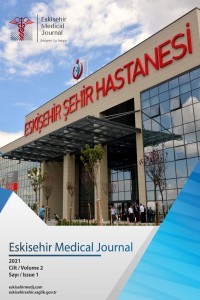Covid-19 Hastalarında D-dimer ve Eritrosit Dağılım Genişliği Arasındaki İlişkinin Klinik Önemi
Eritrosit dağılım genişliği, D-dimer, belirteç
Clinical Significance of the Relationship Between D-dimer and Erythrocyte Distribution Width in Covid-19 Patients
red cell distribution witdh, D-dimer, marker,
___
- References 1. Huang C, Wang Y, Li X, et al. Clinical features of patients infected with 2019 novel coronavirus in Wuhan, China. Lancet. 2020 Feb;395(10223):497–506.
- 2. Tu Y-F, Chien C-S, Yarmishyn AA, et al. A Review of SARS-CoV-2 and the Ongoing Clinical Trials. Int J Mol Sci. 2020 Apr 10;21(7):2657.
- 3. Zhu N, Zhang D, Wang W, et al. A Novel Coronavirus from Patients with Pneumonia in China, 2019. N Engl J Med. 2020 Feb 20;382(8):727–33.
- 4. Iba T, Levy JH, Levi M, Connors JM, Thachil J. Coagulopathy of Coronavirus Disease 2019. Crit Care Med. 2020 May 27;Publish Ah.
- 5. Beun R, Kusadasi N, Sikma M, Westerink J, Huisman A. Thromboembolic events and apparent heparin resistance in patients infected with SARS‐CoV‐2. Int J Lab Hematol. 2020 Jun 15;42(S1):19–20.
- 6. Levi M, Thachil J, Iba T, Levy JH. Coagulation abnormalities and thrombosis in patients with COVID-19. Lancet Haematol. 2020 Jun;7(6):e438–40.
- 7. Wells PS, Anderson DR, Rodger M, et al. Evaluation of D-dimer in the diagnosis of suspected deep-vein thrombosis. N Engl J Med. 2003 Sep 25;349(13):1227–35.
- 8. Frater JL, Zini G, D’Onofrio G, Rogers HJ. COVID‐19 and the clinical hematology laboratory. Int J Lab Hematol. 2020 Jun 15;42(S1):11–8.
- 9. Uslu AU, Yonem O, Aydin B, et al. Red cell distribution width is associated with albuminuria in adults with familial Mediterranean fever. Kaohsiung J Med Sci. 2016;32(4):216–20.
- 10. Ozsu S, Abul Y, Gunaydin S, Orem A, Ozlu T. Prognostic Value of Red Cell Distribution Width in Patients With Pulmonary Embolism. Clin Appl Thromb Hemost. 2014 May 8;20(4):365–70.
- 11. Pehlivanlar Küçük M, Öztuna F, Abul Y, et al. Prognostic value of red cell distribution width and echocardiographic parameters in patients with pulmonary embolism. Adv Respir Med. 2019 Apr 30;87(2):69–76.
- 12. Sunnetcioglu A, Sertogullarindan B, Ozbay B, Asker S, Ekin S. Assessments of the associations of thrombus localization with accompanying disorders, risk factors, D-dimer levels, and the red cell distribution width in pulmonary embolism. Clin (Sao Paulo). 2015 Jun 24;70(6):441–5.
- 13. Celik A, Ozcan IT, Gündes A, et al. Usefulness of admission hematologic parameters as diagnostic tools in acute pulmonary embolism. Kaohsiung J Med Sci. 2015 Mar;31(3):145–9.
- 14. Pan F, Yang L, Li Y, et al. Factors associated with death outcome in patients with severe coronavirus disease-19 (COVID-19): a case-control study. Int J Med Sci. 2020;17(9):1281–92.
- 15. Connors JM, Levy JH. COVID-19 and its implications for thrombosis and anticoagulation. Blood. 2020 Jun 4;135(23):2033–40.
- 16. Kollias A, Kyriakoulis KG, Dimakakos E, et al. Thromboembolic risk and anticoagulant therapy in COVID‐19 patients: emerging evidence and call for action. Br J Haematol. 2020 Jun 4;189(5):846–7.
- 17. Zhang L, Yan X, Fan Q, et al. D‐dimer levels on admission to predict in‐hospital mortality in patients with Covid‐19. J Thromb Haemost. 2020 Jun 4;18(6):1324–9.
- 18. Eichinger S, Minar E, Bialonczyk C, et al. D-dimer levels and risk of recurrent venous thromboembolism. JAMA [Internet]. 2003 Aug 27;290(8):1071–4.
- 19. García Suquia A, Alonso-Fernández A, de la Peña M, et al. High D-dimer levels after stopping anticoagulants in pulmonary embolism with sleep apnoea. Eur Respir J. 2015 Dec;46(6):1691–700.
- 20. Hasegawa M, Wada H, Yamaguchi T, et al. The Evaluation of D-Dimer Levels for the Comparison of Fibrinogen and Fibrin Units Using Different D-Dimer Kits to Diagnose VTE. Clin Appl Thromb Hemost. 2018 May 8;24(4):655–62.
- 21. Tamburello A, Bruno G, Marando M. COVID-19 and Pulmonary Embolism: Not a Coincidence. Eur J Case Rep Intern Med. 2020;7(6):001692.
- 22. Danzi GB, Loffi M, Galeazzi G, Gherbesi E. Acute pulmonary embolism and COVID-19 pneumonia: a random association? Eur Hear J. 2020 May 14;41(19):1858–1858.
- 23. Poggiali E, Bastoni D, Ioannilli E, Vercelli A, Magnacavallo A. Deep Vein Thrombosis and Pulmonary Embolism: Two Complications of COVID-19 Pneumonia? Eur J Case Rep Intern Med. 2020 Apr 8;7(5):1.
- 24. Gao Y, Li T, Han M, et al. Diagnostic utility of clinical laboratory data determinations for patients with the severe COVID‐19. J Med Virol. 2020 Jul 10;92(7):791–6.
- 25. Leonard-Lorant I, Delabranche X, Severac F, et al. Acute Pulmonary Embolism in COVID-19 Patients on CT Angiography and Relationship to D-Dimer Levels. Radiology. 2020 Apr 23;201561.
- 26. Uslu AU, Aydin B, Inal S, et al. The relationship between red cell distribution width and homozygous M694V mutation in familial Mediterranean fever patients. Ann Saudi Med. 2015 Mar;35(2):151–6.
- 27. Shahrbanoo Kheirkham-Sabetghadam, Yaser Jenab, Seyed-Mohammad Ghoreyshi-Hefzabad, et al. Association between elevated red blood cell distribution width and long-term mortality in acute pulmonary embolism. Turk J Med Sci. 2018 Apr 30;48(2).
- 28. Yčas JW, Horrow JC, Horne BD. Persistent increase in red cell size distribution width after acute diseases: A biomarker of hypoxemia? Clin Chim Acta. 2015 Aug;448:107–17.
- 29. Bulut C, Kato Y. Epidemiology of COVID-19. Turk J Med Sci. 2020 Apr 21;50(SI-1):563–70.
- ISSN: 2718-0948
- Yayın Aralığı: Yılda 3 Sayı
- Başlangıç: 2020
- Yayıncı: Eskişehir Şehir Hastanesi
Çok Nadir Birliktelik: Fundus Divertikülü Ve İnce Bağırsak Adenokarsinomu
Covid-19 Hastalarında D-dimer ve Eritrosit Dağılım Genişliği Arasındaki İlişkinin Klinik Önemi
Oğuz GÜRBÜZ, Mehmet Beşir SÜRME
Diyabetik Ayak Ülseri ve Hemşirelik” Konulu Yayınların Bibliyometrik Analizi
Fadime KOYUNCU, Hatice AYHAN, Emine İYİGÜN
Mine TEPETAŞ, Alaettin ÜNSAL, Ahmet AY, Sevda SUNGUR, Didem ARSLANTAŞ, Halime KÜÇÜK
Tıbbi Terminolojide Yunan Mitolojisinin Ayak İzleri
Nadir Olarak Görülen Alüminyum Fosfit Solunmasına Bağlı Zehirlenme Vakası
Demet YALÇIN, Bayram Furkan CANDAN, Mehmet MUTLU, Birgül YELKEN
Vücut Yağ Oranının Kemoterapiye Bağlı Bulantı-Kusma Üzerine Etkisi
Fatih SARGIN, İsmail BEYPINAR, Hasan Şenol COŞKUN
Koroner no-reflow fenomeninde kontrast ilişkili akut böbrek hasarını öngördüren faktörler
Gökay TAYLAN, Çağlar KAYA, İlhan KILIÇ, Cihan ÖZTÜRK, Kenan YALTA
Siroz Hastalarında Resistinin Hastalık Şiddeti, İnflamasyon ve İnsülin Direnci ile İlişkisi
